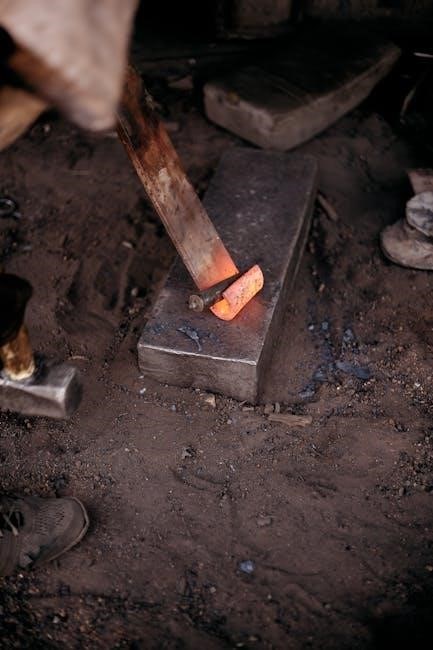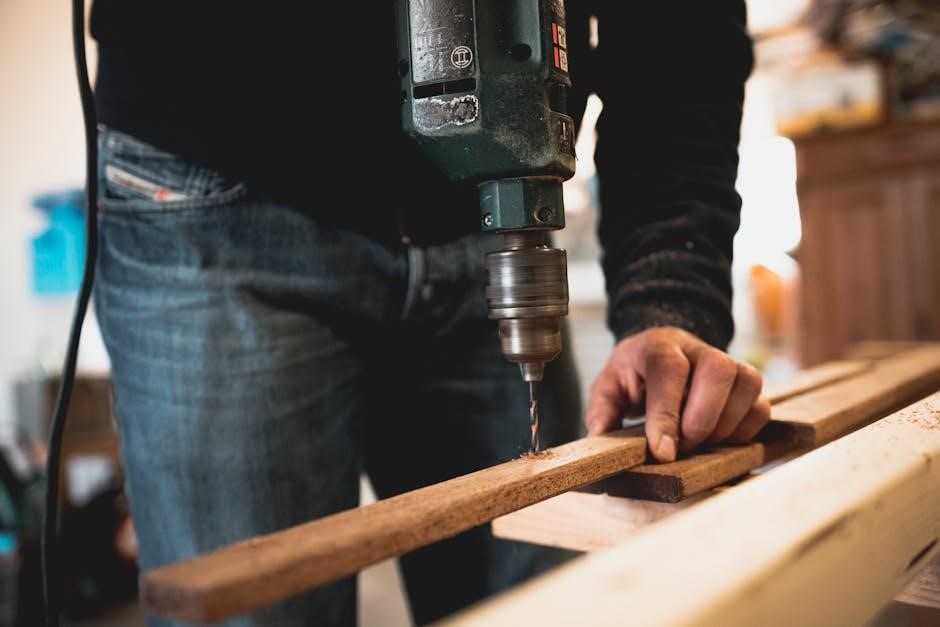Craftsman snowblower manuals provide essential instructions for safe operation, assembly, and maintenance. They are easily accessible online in PDF format, covering various models and configurations.
1.1 Importance of Manuals for Snowblower Operation
Craftsman snowblower manuals are crucial for ensuring safe and efficient operation. They provide detailed instructions for assembly, maintenance, and troubleshooting, helping users avoid costly mistakes. Manuals also outline safety precautions, reducing the risk of accidents. By following the guidelines, users can optimize performance, extend equipment lifespan, and understand warranty terms. They serve as a reference for diagnosing issues and ordering replacement parts. Proper usage, as per the manual, ensures compliance with environmental standards and promotes eco-friendly practices. Regular maintenance schedules and lubrication instructions help maintain the snowblower’s efficiency. Overall, the manual is an essential tool for maximizing functionality and safety while operating a Craftsman snowblower effectively.
1.2 Overview of Craftsman Snowblower Models
Craftsman offers a diverse range of snowblower models, catering to different needs and preferences. From compact, single-stage units ideal for small areas to powerful, two-stage models designed for heavy-duty use, there’s a Craftsman snowblower for every task. Popular models include the 42-inch dual-stage tractor attachment and the 27-inch two-stage power-propelled snow thrower. Each model features unique components and specifications, ensuring optimal performance in varying snow conditions. Manuals for these models provide detailed insights into their operation, maintenance, and troubleshooting, making them indispensable for users. Whether you’re dealing with light snowfall or deep drifts, Craftsman’s lineup has a solution tailored to your requirements, backed by comprehensive manuals for ease of use.
1.3 Where to Find Craftsman Snowblower Manuals Online
Craftsman snowblower manuals are readily available online through various platforms. Websites like ManualsLib and Sears PartsDirect offer free PDF downloads for numerous models, including the Craftsman 944.528398 and 842.240531. Additionally, resources like ManualsLib provide comprehensive guides for models such as the Craftsman 42-inch dual-stage tractor attachment. Many manuals are accessible without registration, while others may require a simple sign-up. Users can also find specific models, such as the Craftsman 536.886261 gas snowblower, through dedicated service pages. These resources ensure that users can easily access the necessary instructions for their snowblowers, regardless of the model or year of purchase.

Safety Instructions in Craftsman Snowblower Manuals
Craftsman manuals emphasize reading before use, wearing protective gear, and avoiding dangerous situations. They highlight exposed rotating parts and proper maintenance for safe operation and injury prevention.
2.1 General Safety Precautions
To ensure safe operation, Craftsman snowblower manuals stress the importance of reading the manual thoroughly before use. Wear protective gear, including gloves and safety glasses, and avoid loose clothing that could get caught in moving parts. Keep children and pets away from the machine while in operation. Never operate the snowblower in enclosed spaces or near open flames due to the risk of carbon monoxide buildup. Ensure all guards and safety devices are in place and functioning properly. Regularly inspect the machine for damage or wear and tear. Always follow proper start-up and shut-off procedures to avoid accidents. These precautions help prevent injuries and ensure optimal performance.
- Read the manual carefully before operating the snowblower.
- Wear appropriate protective gear.
- Keep loose clothing tied back and avoid jewelry.
- Ensure children and pets are at a safe distance.
- Never operate in enclosed or poorly ventilated areas.
- Check for damage or wear before use.
- Follow all safety guidelines to prevent accidents.
By adhering to these precautions, users can minimize risks and maintain warranty coverage.
2.2 Warning Labels and Symbols
Craftsman snowblower manuals emphasize the importance of understanding warning labels and symbols. These are placed on the machine and in the manual to alert users to potential hazards. Common symbols include warnings for rotating parts, hot surfaces, and electrical components. Each label is designed to prevent accidents by highlighting specific dangers, such as entanglement risks or burn hazards. Ignoring these warnings can lead to serious injury or void the warranty. Always locate and review these labels before operating the snowblower. Refer to the manual for explanations of all symbols to ensure safe and proper use of the equipment.
- Warning labels highlight critical safety information.
- Symbols alert users to specific hazards like rotating blades or hot engines.
- Ignoring warnings can result in injury or damage to the machine.
- Review all labels and symbols before operation.
- Consult the manual for detailed explanations of symbols.
Understanding these warnings is essential for safe and effective snowblower operation.
2.3 Protective Gear Recommendations
Craftsman snowblower manuals strongly emphasize the importance of wearing proper protective gear to ensure user safety. Recommended gear includes gloves, safety goggles, and sturdy boots. These items help prevent injuries from debris, cold weather, and accidental contact with moving parts. Additionally, wearing warm, layered clothing is advised to protect against harsh winter conditions. The manual also suggests ensuring that loose clothing or jewelry does not come into contact with the machine. Properly fitted gear ensures comfort and effectiveness, reducing the risk of accidents. Always review and follow these recommendations before operating the snowblower.
- Gloves: Prevent cuts and improve grip control.
- Safety goggles: Protect eyes from flying debris.
- Sturdy boots: Provide traction and prevent slipping.
- Warm clothing: Safeguard against cold-related health issues.
Proper protective gear is essential for safe and effective snowblower operation.

Assembly and Installation Guidelines
Craftsman snowblower manuals provide detailed assembly and installation instructions, including unpacking, inventory checks, and step-by-step assembly procedures. Tractor installation guidance is also included for compatibility.
- Unpack and verify all parts before starting assembly.
- Follow step-by-step instructions for proper assembly.
- Ensure correct installation on tractors for optimal performance.
Proper assembly ensures safe and efficient snowblower operation.
3.1 Unpacking and Inventory of Parts
Begin by carefully unpacking the snowblower and ensuring all components are included. Refer to the manual’s parts list to verify completeness. Check for any damage or missing items. Organize the parts and tools to streamline the assembly process. Pay attention to hardware like bolts, nuts, and pins, as they are essential for proper assembly. Use the provided diagrams to identify each part and its intended location. This step ensures a smooth assembly experience and helps prevent delays. If any parts are missing or damaged, contact Sears immediately for assistance. Proper inventory is crucial for successful assembly and operation of the snowblower.
- Inspect all parts for damage or defects.
- Compare the parts list with the contents of the box.
- Organize parts according to the assembly sequence.
This step ensures everything is ready for assembly.
3.2 Step-by-Step Assembly Instructions
Follow the manual’s detailed instructions for assembling your Craftsman snowblower. Begin by attaching the handlebars securely, ensuring all bolts are tightened properly. Next, install the chute and deflector, aligning them according to the diagrams provided. Attach the auger housing and ensure it is properly seated. Refer to the parts list to confirm all components are correctly fitted. Tighten all connections firmly but avoid over-tightening. Double-check the assembly steps to ensure no parts are misplaced. If unsure, consult the manual’s visual guides for clarity. Proper assembly is crucial for safe and efficient operation. Take your time to complete each step accurately.
- Attach handlebars and tighten bolts.
- Install the chute and deflector.
- Mount the auger housing.
- Verify all connections are secure.
Assembly completion ensures the snowblower is ready for use.
3.3 Installing the Snowblower on a Tractor
Installing a Craftsman snowblower on a tractor requires careful alignment and secure attachment. Begin by preparing the tractor and ensuring the snowblower is fully assembled. Attach the mounting brackets to the tractor’s frame, following the manual’s specifications. Align the snowblower with the tractor’s hitch, ensuring proper connection. Secure the unit using the provided hardware, tightening all bolts firmly. Connect the power take-off (PTO) shaft to the tractor’s PTO outlet, ensuring it is properly engaged. Double-check all connections for stability and safety. Test the setup by running the tractor and snowblower at low speed to ensure smooth operation. Refer to the manual for model-specific installation details to avoid errors.
- Attach mounting brackets to the tractor frame.
- Align and secure the snowblower to the hitch.
- Connect the PTO shaft to the tractor’s outlet.
- Tighten all bolts and test the setup.
Proper installation ensures safe and efficient snowblower operation.

Operating Instructions for Craftsman Snowblowers
Craftsman snowblower manuals detail controls, starting procedures, and techniques for various snow conditions. They emphasize safety, proper usage, and efficient operation for optimal performance and longevity.
4.1 Controls and Features of the Snowblower
Craftsman snowblower manuals outline the controls and features, including speed settings, chute direction, and auger control. These features enhance efficiency and adaptability to different snow conditions, ensuring precise snow removal. The manuals also highlight ergonomic designs for user comfort during operation. Understanding these controls is crucial for safe and effective use, as detailed in the guides.
4.2 Starting and Stopping the Engine
Starting and stopping the engine of a Craftsman snowblower requires careful attention to safety and procedure. Manuals emphasize reading the manual thoroughly before initial start-up. Ensure the area is clear of debris and bystanders. Engage the choke, prime the engine, and pull the starter cord or use the electric start feature. For stopping, disengage the auger and allow the engine to idle before shutting off. Proper shutdown ensures safe operation and prevents damage. Always wear protective gear and follow safety guidelines to avoid accidents. These steps are essential for efficient and safe engine management, as detailed in the manuals.
4.3 Operating Techniques for Different Snow Conditions
Craftsman snowblower manuals provide tailored operating techniques for various snow conditions. For light, fluffy snow, maintain steady forward motion and moderate speed. In heavy, wet snow, reduce speed and clear in smaller passes to avoid clogging. For icy or compacted snow, use the auger at a sharper angle and apply gentle pressure to prevent skidding. Manuals emphasize adjusting skid shoes for different surfaces to maintain traction and avoid damage. Proper techniques ensure efficient clearing, prevent damage, and enhance safety. Adapting methods to snow conditions extends equipment life and improves performance, as outlined in the guides.

Maintenance and Servicing
Regular maintenance is crucial for optimal performance and warranty validity. Manuals outline schedules for lubrication, part inspections, and tune-ups to ensure safe and efficient operation.
5.1 Routine Maintenance Schedule
A well-structured maintenance schedule ensures your Craftsman snowblower runs efficiently and lasts longer. Manuals recommend initial servicing after the first 5 hours of use, followed by regular check-ups every 50 hours. Key tasks include lubricating moving parts, changing engine oil, and inspecting belts and spark plugs. Additionally, checking skid shoes, auger bearings, and discharge chute components is crucial. Proper maintenance not only prevents breakdowns but also ensures safety and optimal performance. Always refer to the manual for specific intervals and procedures tailored to your model. Following this schedule helps maintain warranty validity and ensures reliable operation during harsh winter conditions.
5.2 Lubrication and Oil Change Instructions
Proper lubrication and oil changes are vital for maintaining your Craftsman snowblower. Manuals specify that all moving parts, such as the auger gearbox and chute, should be lubricated regularly. For 4-cycle engines, use SAE 5W-30 oil, and change it every 50 hours or at the start of each season. Warm up the engine before draining oil to ensure a complete drain. Always check oil levels and top off as needed. Refer to the manual for specific locations of grease fittings and oil drain plugs. Using genuine Craftsman parts ensures compatibility and maintains warranty coverage. Regular lubrication prevents wear and keeps the snowblower running smoothly in cold conditions.
5.3 Replacing Belts and Other Wearable Parts
Regular inspection and replacement of belts and wearable parts are essential for optimal performance. Manuals detail when and how to replace these components. Look for signs like cracks, fraying, or uneven wear on belts. Replace them immediately if damaged to prevent breakdowns. Use only genuine Craftsman parts for compatibility and warranty validity. Follow step-by-step instructions in the manual for disassembly and reassembly. Ensure proper tensioning of belts to avoid slippage. Consult the parts diagram for accurate identification and ordering. Lubricate new parts as recommended; Replace worn skid shoes and auger paddles to maintain efficiency. Keep track of replacement intervals to extend your snowblower’s lifespan and reliability.
5.4 Spark Plug Replacement and Tune-Up
Regular spark plug replacement is crucial for maintaining optimal engine performance. Manuals recommend using genuine Craftsman spark plugs for compatibility. To replace, disconnect the spark plug wire, remove the old plug using a spark plug socket, and install the new one with the correct gap. Tighten securely but avoid over-tightening. Tune-ups may include inspecting and cleaning the air filter, checking fuel lines for blockages, and ensuring the carburetor is functioning properly. Refer to the manual for specific torque values and gap settings. Perform this maintenance every 50 hours of operation or as specified to ensure reliable starting and smooth engine operation throughout the winter season.

Parts List and Diagrams
Craftsman snowblower manuals include detailed parts lists and diagrams, helping users identify and order replacement components. These resources are available online in PDF format for easy access.
6.1 Understanding the Parts Diagram
The parts diagram in Craftsman snowblower manuals provides a visual representation of all components, ensuring users can identify and locate parts easily. It is color-coded or labeled to enhance clarity, allowing users to understand how different parts interact. This diagram is essential for maintenance, repairs, and ordering replacement parts. By referencing the parts list, users can cross-check part numbers and descriptions to ensure accuracy. The diagram also highlights wearable parts, aiding in routine inspections. Understanding the parts diagram enables users to perform DIY repairs confidently and maintain their snowblower effectively. Always refer to the diagram when replacing or servicing components to avoid mismatches or damage.

6.2 Ordering Replacement Parts
To order replacement parts for your Craftsman snowblower, refer to the parts diagram in the manual for accurate identification. Note the part number and description, then visit Sears PartsDirect or authorized dealers. Ensure compatibility by matching the model number of your snowblower. Online platforms like ManualsLib and Sears’ official website provide easy access to parts catalogs. For convenience, parts can be shipped directly to your home or made available for in-store pickup. Always verify part numbers before placing an order to avoid errors. Using original equipment manufacturer (OEM) parts ensures proper fitment and maintains warranty coverage. Keep a record of your orders for future reference.

Troubleshooting Common Issues
Craftsman snowblower manuals provide diagnostic techniques and solutions for common problems, enabling users to identify and resolve issues quickly, ensuring optimal performance and extending equipment lifespan.
7.1 Diagnostic Techniques
Diagnostic techniques in Craftsman snowblower manuals guide users through identifying and resolving common issues. These methods include checking for faulty components, verifying proper assembly, and ensuring all safety features function correctly. Manuals often list symptoms, possible causes, and step-by-step solutions, helping users address problems like poor performance or mechanical failure. Regular inspections and adherence to maintenance schedules are emphasized to prevent issues from arising. By following these diagnostic procedures, users can troubleshoot effectively, minimizing downtime and extending the snowblower’s lifespan. Always refer to the manual for specific guidance tailored to your model, ensuring safe and accurate repairs.
7.2 Common Problems and Solutions
Craftsman snowblower manuals outline common issues and their solutions, ensuring optimal performance. Typical problems include the snowblower failing to start, clogged discharge chutes, or belt wear. Solutions often involve checking fuel levels, ensuring proper choke operation, and clearing blockages. Manuals also guide users in replacing worn belts and adjusting auger settings. Regular maintenance, like lubricating moving parts and inspecting cables, prevents many issues. For complex problems, manuals recommend consulting a parts diagram or contacting Sears for support. By addressing these common challenges, users can resolve issues efficiently and maintain their snowblower’s functionality throughout the winter season.

Warranty and Service Information
Craftsman snowblower manuals detail a two-year warranty covering defects in material and workmanship. Sears provides repair services free of charge when maintained as per instructions.
8.1 Warranty Coverage Details
Craftsman snowblower manuals outline a comprehensive two-year warranty, effective from the date of purchase. This warranty covers defects in material and workmanship when the snowblower is properly maintained, lubricated, and tuned according to the manual’s instructions. During this period, Sears will repair or replace defective parts free of charge. The warranty ensures customer satisfaction by addressing issues promptly, provided the snowblower is used as directed. This coverage underscores Sears’ commitment to quality and reliability, offering peace of mind to users. Proper documentation and proof of purchase are required to avail of warranty services.
8.2 Contacting Sears for Service and Support
For service and support, users can contact Sears through their official website or visit the nearest Sears Parts & Repair center. The manuals provide detailed contact information and guidelines for requesting assistance. Sears offers comprehensive support, including parts inquiries, repair services, and warranty claims. Users can also access online resources, such as parts diagrams and troubleshooting guides, to resolve common issues independently. Sears emphasizes customer satisfaction, ensuring timely and effective solutions for Craftsman snowblower owners. Reaching out to Sears directly is recommended for genuine parts and expert advice, ensuring optimal performance and safety of the snowblower.

Environmental and Disposal Considerations
Craftsman snowblower manuals emphasize eco-friendly maintenance and proper disposal of old units, ensuring environmental safety and reducing waste.
9.1 Proper Disposal of Old Snowblowers
Proper disposal of old Craftsman snowblowers is crucial for environmental safety. Users should follow local regulations and guidelines for disposing of large appliances. Many communities offer recycling programs for metal and plastic components, ensuring materials are repurposed responsibly. Additionally, hazardous materials like batteries and fluids must be handled separately to prevent contamination. Always remove fuel and oil before disposal, as these substances can harm the environment if not disposed of correctly. Check with local waste management facilities for specific instructions on recycling or safe disposal methods. Proper disposal helps reduce waste and promotes eco-friendly practices.
9.2 Eco-Friendly Maintenance Practices
Eco-friendly maintenance practices for Craftsman snowblowers involve using biodegradable lubricants and fuels to minimize environmental impact. Regular tune-ups and inspections ensure efficient operation, reducing emissions and energy waste. Proper disposal of used fluids and filters is essential to prevent soil and water contamination. Cleaning the snowblower after use prevents rust and extends its lifespan, reducing the need for frequent replacements. Energy-efficient operation can be achieved by maintaining sharp blades and ensuring proper belt tension. Using original equipment manufacturer (OEM) parts promotes durability and reduces waste. Always follow the manual’s guidelines for eco-conscious maintenance to support sustainability and protect the environment.
Craftsman snowblower manuals are essential resources for optimal performance, safety, and maintenance. They provide detailed guidance for operation, troubleshooting, and eco-friendly practices, ensuring longevity and efficiency. By following these manuals, users can maximize their snowblower’s potential while adhering to environmental standards. The comprehensive instructions cover everything from assembly to warranty details, making them indispensable for both novice and experienced users. Accessible online in PDF format, these manuals empower owners to maintain their equipment responsibly and sustainably, ensuring reliable service for years to come. Always refer to your manual for the best practices in snowblower care and operation.
